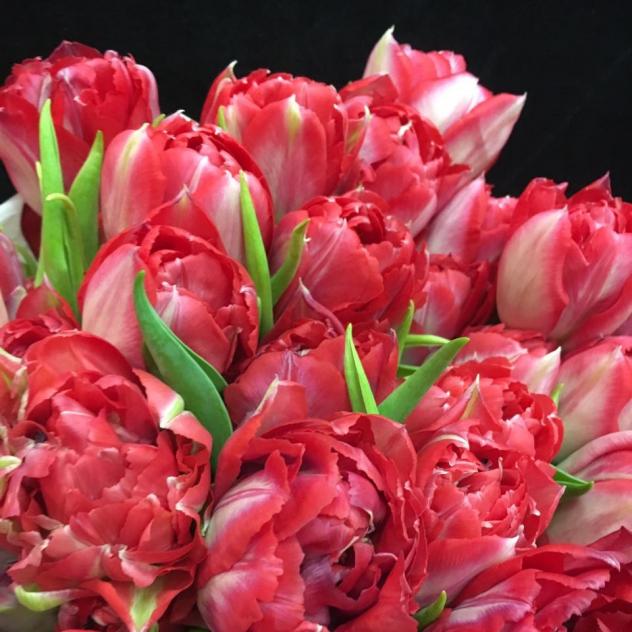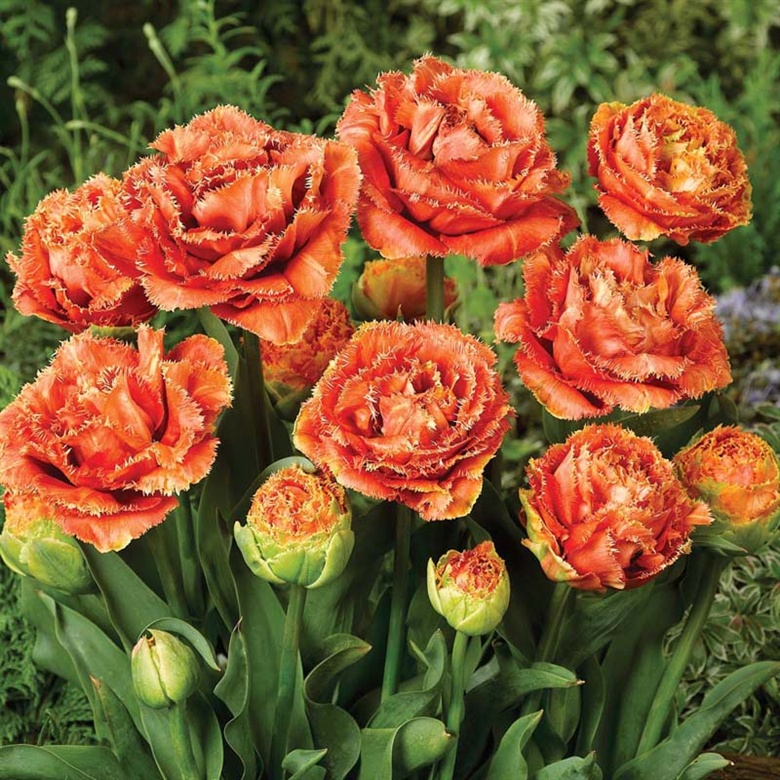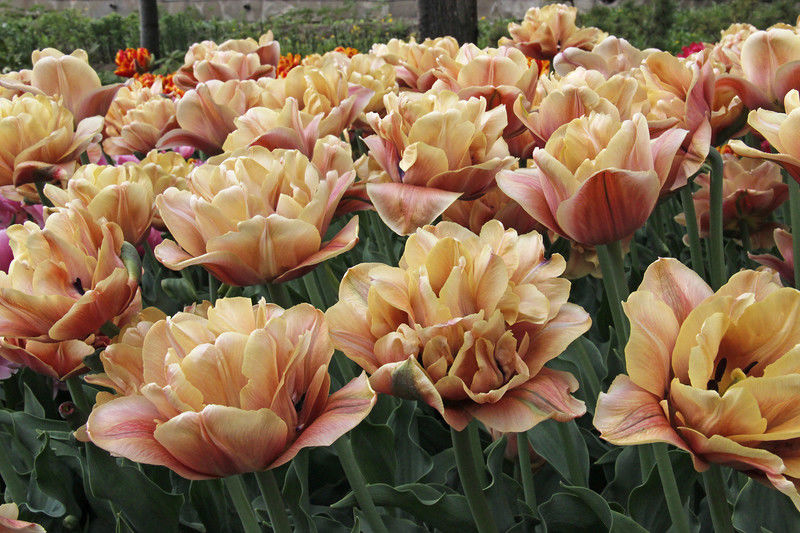Content:
Tulips are one of those flowers that few people can remain indifferent to. These are delicate and beautiful plants that will bring great joy when they bloom in a flower bed. Peony tulips look especially impressive. This article discusses their features and growing technology.
Peony tulips: description and features
Tulips belonging to this class are distinguished by thick, lush buds, large petals, which are very similar to the flowers of peonies. Peony tulips are large enough. They have a long stem, which is often taller than 40-60 cm. The use of this class of tulips is not limited to flower gardens. They can be planted under trees, on alpine hills, they can be used to decorate balconies and flowerpots.
Peony tulips are not a new species. They existed as early as the 17th century. And it is not surprising that over such a long period, breeders were able to breed a huge number of varieties of these flowers.
There are varieties that differ in flowering seasons: there are those that bloom in the spring, and there are tulips that bloom in June. There are varieties that differ in bud size (small, medium, large flowers) and whose distinguishing feature is the length of the stem. With the right approach to the cultivation of these flowers, the combination of colors and sizes, you can create a wonderful composition in the garden of various types of peony tulips.
The best varieties for the garden
Here are the brightest varieties of peony tulips:
- Royal Acres (Royal Acres) - a variety of tulips, a distinctive feature of which is a lush, large-leaved inflorescence of a very rich purple color. Has a fairly high stem (50-60 cm). Perfect for growing on the territory of Russia, as it tolerates temperature instability and frequent frosts very firmly. Suitable for growing in flowerpots and flower beds in the garden. Flowering occurs mainly in May.
- Monte Carlo. These flowers have a huge bright yellow bud. The height of the stem reaches 40 cm, the inflorescence can reach 10 cm in diameter. Due to its rich color, it is very popular as a landscape decoration. The variety is resistant to variegated disease, blooms beautifully on sunny warm days. The flowering period is April and May.
- Sensual Touch (Sensual Touch). These are graceful flowers of a pale orange color with a neat fringe of the petals. The bud is quite lush due to the large number of petals (diameter from 10 cm and more). The stem height is approximately 50 cm. The variety is very popular for decorative planting, as well as for creating bouquets. Flowers are unpretentious, easy to reproduce. Flowering occurs in May.
- Humilis Tet-a-Tete (Tulipa humilis 'Tete-a-Tete') are red flowers with pale green strokes on the outside of the petal. Pointed petals form a tight berry-shaped (spherical) bud. Small in height - up to 10 cm. Used by landscape designers to create an alpine slide. The flowering period occurs in early spring, mainly April.
- Cartouche (Cartouche) - a flower, the hallmark of which is its unique color. The wide petal is beige, almost white, and its edges seem to be casually sprinkled with red, almost pink paint. The bud is quite wide, exuding a pleasant sweet aroma. Stem height does not exceed 55 cm. It is a very light-loving plant. It is grown mainly in flower beds and potted houses. Flowering occurs in April.
- Mint Tacoma (Mount Tacoma) is a delightful snow-white tulip with a lush bud up to 10 cm in diameter and wide petals. Stem height 40-45 cm. It is used for landscaping flower beds and creating bouquets. The flowering period is very long (up to 3 weeks) and starts in mid-May. Also, a distinctive feature of this variety of peonies is considered to be long preservation in a cut form.
- La Belle Epoque is a flower with very large buds and wide peach-colored petals, turning slightly golden at the edges. The height of the stem is not very large, it can reach about 15 cm, and the flower diameter is up to 10 cm. It is used for planting in flower beds, garden decor and bouquets. It is stored for a very long time in cut form. A light-loving, spring plant that blooms in May.
- Peach Blossom - a flower with a pleasant light pink almost pearlescent bud. The petals darken towards the middle and almost completely lighten at the edges, on the outside they have a dense green vein. The stem of the tulip is not the highest (up to 35 cm), but the blossoming bud exceeds 12 cm in diameter. These flowers are perfect for garden decoration. They love light and dry land. Bloom in early spring.
- Double Red Riding Hood. This peony tulip variety speaks for itself. The flowers have wide, bright red buds, the petals of which are very narrow, but close-set, which creates an excellent flower arrangement. Stem height 35 cm. Perfect for decorating a flower garden, flower bed or alpine slide. The peculiarity of these tulips is that the flower does not bloom in the shade, so they need to be planted in a lighted place. The flowering period falls in May or April and is about a month.
There is also another kind of tulip flowers. This refers to the pelargonium Patricia Andrea. It is a very large geranium variety with red, round, tulip-like buds and dark green leaves. Pelargonium Patricia Andrea flowers, unlike single tulips, are collected in lush inflorescences. This is a very delicate and whimsical plant that is not grown outdoors in the harsh Russian climate, but is used to decorate an apartment as a houseplant. Pelargonium Patricia Andrea is susceptible to many diseases and degenerates if not properly cared for.
Agrotechnology for growing peony tulips
In terms of planting, this variety is no different from planting ordinary tulips, although there are still some nuances:
Buying bulbs and preparing for planting
Bulbs for planting peony tulips can be purchased online, at fairs or in garden shops. It is worthwhile to carefully approach this issue, since sellers often give out one variety after another. It is advisable to take someone who is well versed in colors with you to the store, and if the purchase is made via the Internet, then it is best to choose proven sites.
It is recommended to buy bulbs closer to planting. You need to choose those that are medium in size, covered with brown scales of medium density. If the planting material was purchased earlier than planned, then it is better to place it in a warm, dry place before planting. Before planting, you need to carefully examine the bulbs for cracks and rot. If they are dry, then before planting, it is recommended to soak in water for half an hour.
When the bulbs are ready, they can be planted. Depending on the region, planting occurs either in mid-September or early October.
Site preparation
Site selection is very important. Tulips do not like excessive moisture and shade. The location should be chosen with this in mind. It is important to remember that in the place where tulips are planted, nothing should grow for 3 years. In addition, before planting, you need to determine the acid-base balance of the soil (pH should not be more than 7). Soil with high acidity should be sprinkled with lime. For feeding, it is better to use humus, sand.
Planting bulbs
After preparing the soil, you can dig out the beds. They should be about 15-20 cm deep and have a substrate of 3 cm.Tulips do not like to be close to each other, therefore, the bulbs should be planted at a distance of more than 10 cm.After the beds, they fall asleep, watered and covered with peat and sawdust for warming before the winter cold ...
Further care
After planting, during which all the rules were observed, tulips no longer require attention. Only in spring, before the beginning of flowering, the beds should be watered, and when the first shoots appear, remove the top layer of peat and sawdust.
During the period of bud formation, the plants need to be fed with a complex containing potassium and phosphorus. Also, this fertilizer is applied after flowering to nourish the bulb. In order to avoid the invasion of pests, it is worth sprinkling the flower beds with a weak solution of potassium permanganate from a spray bottle.
After the flowering period has passed, the bulbs need to be dug out, sorted out, removed to a warm, dry place for a month. Further, it is recommended to keep them at a temperature not exceeding 20 ° С, and before planting not more than 15 ° С. After the bulbs can be planted again, following the rules outlined above.
Tulips are the most popular and beautiful spring flowers. Having bought a suitable variety and having carried out the correct planting, in early spring with the blooming of the buds, the florist will not regret his choice.
















